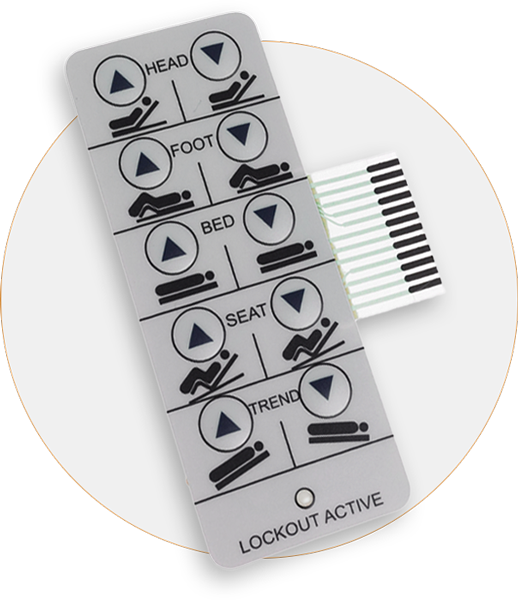How to Pick the Right Membrane Switch for Your Electronics Project
Why Membrane Switches Over Are Essential for Durable Control Equipment
Membrane layer buttons play an essential duty in making certain the durability and reliability of control systems throughout numerous markets. Their distinct construction allows them to endure challenging ecological elements such as moisture, temperature level extremes, and physical wear. This durability not only expands the life-span of the systems they serve but also decreases upkeep requirements. As we check out the complex benefits of membrane switches, it comes to be obvious that their importance transcends simple performance, influencing individual experience and operational efficiency. What further effects do these attributes hold for the future of control system style?
Review of Membrane Switches
Membrane layer switches are functional and reputable components frequently made use of in various electronic control systems. These switches contain numerous layers, consisting of a graphic overlay, a spacer layer, and a printed circuit layer. The graphic overlay supplies both useful and visual design, while the spacer layer makes sure that the buttons are activated only when pushed. The published circuit layer consists of conductive traces that finish an electric circuit when the membrane is pressed, allowing the device to reply to individual inputs.
Membrane buttons are often favored in applications calling for a portable and lightweight design, making them ideal for handheld devices, medical tools, and commercial equipment. They can be personalized to satisfy certain user demands and can incorporate various attributes such as backlighting, responsive comments, and multiple shades. Membrane layer buttons are resistant to dirt, dampness, and impurities, making them ideal for atmospheres where durability is important.
Advantages of Durability
In several applications, the toughness of membrane layer changes offers significant advantages that enhance their total performance and dependability. These switches are made to stand up to harsh settings, making them optimal for usage in requiring conditions such as high moisture, extreme temperature levels, and exposure to chemicals. Their durable building and construction assists to avoid damages from physical impact, making sure durable performance and minimizing the demand for frequent replacements.
In addition, membrane layer switches are immune to deterioration, which is critical in applications where frequent communication takes place. This sturdiness converts to lower upkeep prices, as organizations gain from lowered downtime and less solution disturbances. The encapsulated design of membrane layer changes protects internal parts from dirt and dampness access, more adding to their life-span (membrane switch).
One more benefit is their ability to keep consistent performance with time. With a high resistance for mechanical anxiety, these buttons preserve their responsive comments and electric stability, making sure customer complete satisfaction. Inevitably, the sturdiness of membrane switches not just enhances operational efficiency however likewise promotes self-confidence in their dependability, making them a recommended choice for control systems throughout different industries.
Applications in Different Industries
Resilient control systems utilizing membrane buttons find comprehensive applications throughout a series of sectors, each gaining from the distinct features these switches offer. In the medical industry, membrane layer switches are critical for tools such as patient screens and diagnostic tools, where reliability and convenience of cleansing are paramount. Their resistance to dampness and contaminants guarantees they preserve functionality in clean and sterile atmospheres.
The vehicle sector leverages membrane layer switches for control panel controls and infotainment systems, where they give streamlined, inconspicuous user interfaces that improve customer experience. These switches are also designed to stand up to severe problems, consisting of direct exposure to extreme temperatures and vibrations.
In commercial settings, membrane buttons are commonly made use of in machinery control panels, supplying responsive responses and durability required for high-usage applications. Their capacity to resist chemicals makes them suitable for making atmospheres where spills and pollutants are frequent.

Customer electronic devices, such as kitchen area appliances and push-button controls, additionally utilize membrane layer buttons for their convenience and cost-effectiveness. Overall, the versatility and robust nature of membrane layer switches make them essential across different sectors, guaranteeing effective operation and longevity in control systems.
Design and Visual Charm
While performance is critical, the design and visual allure of control systems geared up with membrane layer buttons play an important role in individual engagement and overall experience (membrane switch). The aesthetic layout of these switches can dramatically affect customer assumption and communication. A properly designed membrane layer switch improves the appearance of the device, making it a lot more enticing to customers and fostering a connection between the user and the product
Membrane layer changes use a large amount of adaptability in design, enabling manufacturers to customize graphics, colors, and textures to align with brand identity and product visual appeals. Making use of vibrant shades and distinctive patterns can attract attention, while tactile responses can reinforce the individual's interaction with the gadget. In addition, the capacity to incorporate LED signs and backlighting right into the membrane switch layout offers both practical and aesthetic benefits, enhancing exposure and functionality in various settings.

Enhancing Individual Experience

Furthermore, membrane switches can be personalized to include visual user interfaces, boosting usability by presenting info in a clear and instinctive fashion (membrane switch). This modification can consist of symbols, tags, and shade coding that overview customers via facility functionalities with ease. Additionally, their flexibility permits combination in numerous settings, making certain consistent efficiency whether in industrial equipment or consumer electronic devices
The toughness of membrane buttons likewise plays a critical function in user experience. By enduring severe conditions and prolonged use, these switches decrease the likelihood of system failings, hence promoting dependability and customer self-confidence. Eventually, the tactical use membrane layer changes not just boosts capability but also dramatically enriches individual communication with control systems, making them a crucial part in contemporary style.
Conclusion
